A Neuroergonomic Approach Fostered by Wearable EEG for the Multimodal Assessment of Drivers Trainees
Abstract
:1. Introduction
- Section 2 is aimed at providing a clear and detailed description of the overall methodological implant, including the experimental design and related tasks, the data collection and processing, and the following statistical analysis;
- Section 3 is aimed at describing the obtained results;
- Section 4 is aimed at discussing results, even commenting the weaknesses of the present study and suggesting further improvements;
- Section 5, being the conclusions, is aimed at summarizing the main outcomes of the study.
2. Materials and Methods
2.1. Experimental Task
2.1.1. Adaptation Task
2.1.2. Easy and Hard Driving Tasks
2.1.3. Urban Driving Tasks
2.2. Experimental Participants
2.3. Experimental Protocol
2.4. Methods
2.4.1. Electroencephalographic Data Recording and Analysis
2.4.2. Subjective Assessment
- Mental demand: How much mental and perceptual activity was required? Was the task easy or demanding, simple or complex?
- Physical demand: How much physical activity was required? Was the task easy or demanding, slack or strenuous?
- Temporal demand: How much time pressure did you feel due to the pace at which the tasks or task elements occurred? Was the pace slow or rapid?
- Performance: How successful were you in performing the task? How satisfied were you with your performance?
- Effort: How hard did you have to work (mentally and physically) to accomplish your level of performance?
- Frustration: How irritated, stressed, and annoyed versus content, relaxed, and complacent did you feel during the task?
2.4.3. Behavioural Assessment
- -
- Driving performance: the simulator collects the number of collisions between the driver’s car and (i) the other cars, (ii) the road signs, and (iii) the road infrastructure, such as the sidewalks. The total number of collisions for each participant for each Run was estimated. It was hypothesized an inverse correlation with performance: the better the participant became at driving, the fewer collisions it would have to make.
- -
- Mental performance: the reaction times to the failure events were collected for each participant for each Run and averaged along the Run itself (there were two occurrence). In fact, the reaction to failures can be considered as a secondary task. According to the scientific literature related to the dual tasks interference, even while driving [65], with human mental resources being not unlimited, the more resources are allocated to the primary task, the more difficult it will be to manage a secondary task. Vice versa, the more experienced we become and able to perform the primary task automatically, the more we will improve our ability to handle secondary tasks, such as the reaction to additional and unexpected events. Therefore, a direct correlation was expected between improvement on the primary (driving) and the secondary (reaction to failure) tasks: the better the participant became at driving, the faster reaction times it would have to achieve.
2.4.4. Performed Analysis
3. Results
3.1. Subjective Assessment
- (1)
- Effort: F (4, 68) = 1.232; p = 0.306;
- (2)
- Performance: F (4, 68) = 2.224; p = 0.076;
- (3)
- Workload: F (4, 68) = 0.195; p = 0.940.
3.2. Behavioural Assessment
3.3. Neurophysiological Assessment
4. Discussion
5. Conclusions
Author Contributions
Funding
Institutional Review Board Statement
Informed Consent Statement
Data Availability Statement
Acknowledgments
Conflicts of Interest
References
- Parker, D.; Manstead, A.S.R. The Social Psychology of Driver Behaviour. In Applied Social Psychology; Semin, G.R., Fiedler, K., Eds.; Sage: London, UK, 1996; pp. 198–224. ISBN 978-0-8039-7926-0. [Google Scholar]
- De Waard, D. The Measurement of Drivers’ Mental Workload; University of Groningen, Traffic Research Centre: Groningen, The Netherlands, 1996. [Google Scholar]
- Evans, L. Traffic Safety and the Driver; Science Serving Society: Bloomfield Hills, MI, USA, 1991; ISBN 978-0-442-00163-6. [Google Scholar]
- Simonetti, I.; Tamborra, L.; Giorgi, A.; Ronca, V.; Vozzi, A.; Aricò, P.; Borghini, G.; Sciaraffa, N.; Trettel, A.; Babiloni, F.; et al. Neurophysiological Evaluation of Students’ Experience during Remote and Face-to-Face Lessons: A Case Study at Driving School. Brain Sci. 2023, 13, 95. [Google Scholar] [CrossRef] [PubMed]
- Istituto Nazionale di Statistica. Incidenti Stradali; Istituto Nazionale di Statistica (ISTAT): Rome, Italy, 2020. [Google Scholar]
- Carson, J.; Jost, G.; Meinero, M. Ranking EU Progress on Road Safety; Road Safety Performance Index Report; European Transport Safety Council: Brussels, Belgium, 2023. [Google Scholar]
- Gicquel, L.; Ordonneau, P.; Blot, E.; Toillon, C.; Ingrand, P.; Romo, L. Description of Various Factors Contributing to Traffic Accidents in Youth and Measures Proposed to Alleviate Recurrence. Front. Psychiatry 2017, 8, 94. [Google Scholar] [CrossRef] [PubMed]
- Position Paper—Revision of the Driving Licence Directive 2006/126/EC—ETSC. Available online: https://etsc.eu/position-paper-revision-of-the-driving-licence-directive-2006-126-ec/ (accessed on 14 September 2023).
- Driving Licence. Available online: https://road-safety.transport.ec.europa.eu/eu-road-safety-policy/priorities/driving-licence_en (accessed on 14 September 2023).
- Da Silva, F.P. Mental Workload, Task Demand and Driving Performance: What Relation? Procedia Soc. Behav. Sci. 2014, 162, 310–319. [Google Scholar] [CrossRef]
- Aricò, P.; Borghini, G.; Flumeri, G.D.; Sciaraffa, N.; Babiloni, F. Passive BCI beyond the Lab: Current Trends and Future Directions. Physiol. Meas. 2018, 39, 08TR02. [Google Scholar] [CrossRef] [PubMed]
- Parasuraman, R. Neuroergonomics: Brain, Cognition, and Performance at Work. Curr. Dir. Psychol. Sci. 2011, 20, 181–186. [Google Scholar] [CrossRef]
- Gramann, K.; Fairclough, S.H.; Zander, T.O.; Ayaz, H. Editorial: Trends in Neuroergonomics. Front. Hum. Neurosci. 2017, 11, 165. [Google Scholar] [CrossRef]
- Borghini, G.; Aricò, P.; Di Flumeri, G.; Sciaraffa, N.; Colosimo, A.; Herrero, M.-T.; Bezerianos, A.; Thakor, N.V.; Babiloni, F. A New Perspective for the Training Assessment: Machine Learning-Based Neurometric for Augmented User’s Evaluation. Front. Neurosci. 2017, 11, 325. [Google Scholar] [CrossRef]
- Borghini, G.; Aricò, P.; Di Flumeri, G.; Ronca, V.; Giorgi, A.; Sciaraffa, N.; Conca, C.; Stefani, S.; Verde, P.; Landolfi, A.; et al. Air Force Pilot Expertise Assessment during Unusual Attitude Recovery Flight. Safety 2022, 8, 38. [Google Scholar] [CrossRef]
- Mancini, M.; Cherubino, P.; di Flumeri, G.; Cartocci, G.; Martinez, A.; Sanchez, A.; Santillo, C.; Modica, E.; Vozzi, A.; Ronca, V.; et al. Neuroscientific Methods for Exploring User Perceptions While Dealing with Mobile Advertising: A Novel and Integrated Approach. Front. Neuroergonomics 2022, 3, 835648. [Google Scholar] [CrossRef]
- Sciaraffa, N.; Borghini, G.; Di Flumeri, G.; Cincotti, F.; Babiloni, F.; Aricò, P. Joint Analysis of Eye Blinks and Brain Activity to Investigate Attentional Demand during a Visual Search Task. Brain Sci. 2021, 11, 562. [Google Scholar] [CrossRef]
- Marucci, M.; Di Flumeri, G.; Borghini, G.; Sciaraffa, N.; Scandola, M.; Pavone, E.F.; Babiloni, F.; Betti, V.; Aricò, P. The Impact of Multisensory Integration and Perceptual Load in Virtual Reality Settings on Performance, Workload and Presence. Sci. Rep. 2021, 11, 4831. [Google Scholar] [CrossRef]
- Mandryk, R.L.; Inkpen, K.M.; Calvert, T.W. Using Psychophysiological Techniques to Measure User Experience with Entertainment Technologies. Behav. Inf. Technol. 2006, 25, 141–158. [Google Scholar] [CrossRef]
- Čertický, M.; Čertický, M.; Sinčák, P.; Magyar, G.; Vaščák, J.; Cavallo, F. Psychophysiological Indicators for Modeling User Experience in Interactive Digital Entertainment. Sensors 2019, 19, 989. [Google Scholar] [CrossRef] [PubMed]
- Di Flumeri, G.; Aricò, P.; Borghini, G.; Sciaraffa, N.; Di Florio, A.; Babiloni, F. The Dry Revolution: Evaluation of Three Different EEG Dry Electrode Types in Terms of Signal Spectral Features, Mental States Classification and Usability. Sensors 2019, 19, 1365. [Google Scholar] [CrossRef] [PubMed]
- Sciaraffa, N.; Di Flumeri, G.; Germano, D.; Giorgi, A.; Di Florio, A.; Borghini, G.; Vozzi, A.; Ronca, V.; Babiloni, F.; Aricò, P. Evaluation of a New Lightweight EEG Technology for Translational Applications of Passive Brain-Computer Interfaces. Front. Hum. Neurosci. 2022, 16, 901387. [Google Scholar] [CrossRef]
- Niso, G.; Romero, E.; Moreau, J.T.; Araujo, A.; Krol, L.R. Wireless EEG: A Survey of Systems and Studies. NeuroImage 2023, 269, 119774. [Google Scholar] [CrossRef]
- Ronca, V.; Martinez-Levy, A.C.; Vozzi, A.; Giorgi, A.; Aricò, P.; Capotorto, R.; Borghini, G.; Babiloni, F.; Di Flumeri, G. Wearable Technologies for Electrodermal and Cardiac Activity Measurements: A Comparison between Fitbit Sense, Empatica E4 and Shimmer GSR3+. Sensors 2023, 23, 5847. [Google Scholar] [CrossRef]
- Johnson, K.T.; Picard, R.W. Advancing Neuroscience through Wearable Devices. Neuron 2020, 108, 8–12. [Google Scholar] [CrossRef] [PubMed]
- Giorgi, A.; Ronca, V.; Vozzi, A.; Sciaraffa, N.; di Florio, A.; Tamborra, L.; Simonetti, I.; Aricò, P.; Di Flumeri, G.; Rossi, D.; et al. Wearable Technologies for Mental Workload, Stress, and Emotional State Assessment during Working-Like Tasks: A Comparison with Laboratory Technologies. Sensors 2021, 21, 2332. [Google Scholar] [CrossRef]
- Sciaraffa, N.; Arico, P.; Borghini, G.; Di Flumeri, G.; Di Florio, A.; Babiloni, F. The Evolution of Passive Brain–Computer Interfaces: Enhancing the Human–Machine Interaction. In Neurotechnology: Methods, Advances and Applications; De Albuquerque, V.H., Athanasiou, A., Ribeiro, S., Eds.; Institution of Engineering and Technology: London, UK, 2020; pp. 155–179. ISBN 978-1-78561-813-0. [Google Scholar]
- Aricò, P.; Reynal, M.; Di Flumeri, G.; Borghini, G.; Sciaraffa, N.; Imbert, J.-P.; Hurter, C.; Terenzi, M.; Ferreira, A.; Pozzi, S.; et al. How Neurophysiological Measures Can Be Used to Enhance the Evaluation of Remote Tower Solutions. Front. Hum. Neurosci. 2019, 13, 303. [Google Scholar] [CrossRef]
- Casson, A.J. Wearable EEG and beyond. Biomed. Eng. Lett. 2019, 9, 53–71. [Google Scholar] [CrossRef] [PubMed]
- Ronca, V.; Di Flumeri, G.; Vozzi, A.; Giorgi, A.; Aricò, P.; Sciaraffa, N.; Babiloni, F.; Borghini, G. Validation of an EEG-Based Neurometric for Online Monitoring and Detection of Mental Drowsiness While Driving. In Proceedings of the 2022 44th Annual International Conference of the IEEE Engineering in Medicine & Biology Society (EMBC), Glasgow, UK, 11–15 July 2022; pp. 3714–3717. [Google Scholar]
- Vozzi, A.; Ronca, V.; Aricò, P.; Borghini, G.; Sciaraffa, N.; Cherubino, P.; Trettel, A.; Babiloni, F.; Di Flumeri, G. The Sample Size Matters: To What Extent the Participant Reduction Affects the Outcomes of a Neuroscientific Research. A Case-Study in Neuromarketing Field. Sensors 2021, 21, 6088. [Google Scholar] [CrossRef] [PubMed]
- Di Flumeri, G.; De Crescenzio, F.; Berberian, B.; Ohneiser, O.; Kramer, J.; Aricò, P.; Borghini, G.; Babiloni, F.; Bagassi, S.; Piastra, S. Brain–Computer Interface-Based Adaptive Automation to Prevent Out-Of-The-Loop Phenomenon in Air Traffic Controllers Dealing with Highly Automated Systems. Front. Hum. Neurosci. 2019, 13, 296. [Google Scholar] [CrossRef] [PubMed]
- Di Flumeri, G.; Borghini, G.; Aricò, P.; Sciaraffa, N.; Lanzi, P.; Pozzi, S.; Vignali, V.; Lantieri, C.; Bichicchi, A.; Simone, A.; et al. EEG-Based Mental Workload Neurometric to Evaluate the Impact of Different Traffic and Road Conditions in Real Driving Settings. Front. Hum. Neurosci. 2018, 12, 509. [Google Scholar] [CrossRef] [PubMed]
- Brookhuis, K.A.; de Waard, D. Monitoring Drivers’ Mental Workload in Driving Simulators Using Physiological Measures. Accid. Anal. Prev. 2010, 42, 898–903. [Google Scholar] [CrossRef] [PubMed]
- Kim, H.S.; Hwang, Y.; Yoon, D.; Choi, W.; Park, C.H. Driver Workload Characteristics Analysis Using EEG Data from an Urban Road. IEEE Trans. Intell. Transp. Syst. 2014, 15, 1844–1849. [Google Scholar] [CrossRef]
- Islam, M.R.; Barua, S.; Ahmed, M.U.; Begum, S.; Aricò, P.; Borghini, G.; Di Flumeri, G. A Novel Mutual Information Based Feature Set for Drivers’ Mental Workload Evaluation Using Machine Learning. Brain Sci. 2020, 10, 551. [Google Scholar] [CrossRef]
- Guo, Z.; Pan, Y.; Zhao, G.; Cao, S.; Zhang, J. Detection of Driver Vigilance Level Using EEG Signals and Driving Contexts. IEEE Trans. Reliab. 2018, 67, 370–380. [Google Scholar] [CrossRef]
- Wang, Y.-K.; Jung, T.-P.; Chen, S.-A.; Huang, C.-S.; Lin, C.-T. Tracking Attention Based on EEG Spectrum. In Proceedings of the HCI International 2013—Posters’ Extended Abstracts, Las Vegas, NV, USA, 21–26 July 2013; Stephanidis, C., Ed.; Springer: Berlin/Heidelberg, Germany, 2013; pp. 450–454. [Google Scholar]
- Aminosharieh Najafi, T.; Affanni, A.; Rinaldo, R.; Zontone, P. Driver Attention Assessment Using Physiological Measures from EEG, ECG, and EDA Signals. Sensors 2023, 23, 2039. [Google Scholar] [CrossRef]
- Wang, Y.-K.; Jung, T.-P.; Lin, C.-T. EEG-Based Attention Tracking during Distracted Driving. IEEE Trans. Neural Syst. Rehabil. Eng. 2015, 23, 1085–1094. [Google Scholar] [CrossRef]
- Borghini, G.; Astolfi, L.; Vecchiato, G.; Mattia, D.; Babiloni, F. Measuring Neurophysiological Signals in Aircraft Pilots and Car Drivers for the Assessment of Mental Workload, Fatigue and Drowsiness. Neurosci. Biobehav. Rev. 2014, 44, 58. [Google Scholar] [CrossRef] [PubMed]
- Di Flumeri, G.; Ronca, V.; Giorgi, A.; Vozzi, A.; Aricò, P.; Sciaraffa, N.; Zeng, H.; Dai, G.; Kong, W.; Babiloni, F.; et al. EEG-Based Index for Timely Detecting User’s Drowsiness Occurrence in Automotive Applications. Front. Hum. Neurosci. 2022, 16, 866118. [Google Scholar] [CrossRef] [PubMed]
- Arefnezhad, S.; Hamet, J.; Eichberger, A.; Frühwirth, M.; Ischebeck, A.; Koglbauer, I.V.; Moser, M.; Yousefi, A. Driver Drowsiness Estimation Using EEG Signals with a Dynamical Encoder–Decoder Modeling Framework. Sci. Rep. 2022, 12, 2650. [Google Scholar] [CrossRef] [PubMed]
- Li, G.; Chung, W.-Y. Electroencephalogram-Based Approaches for Driver Drowsiness Detection and Management: A Review. Sensors 2022, 22, 1100. [Google Scholar] [CrossRef] [PubMed]
- Kong, W.; Zhou, Z.; Jiang, B.; Babiloni, F.; Borghini, G. Assessment of Driving Fatigue Based on Intra/Inter-Region Phase Synchronization. Neurocomputing 2017, 219, 474–482. [Google Scholar] [CrossRef]
- Apicella, A.; Arpaia, P.; Isgrò, F.; Mastrati, G.; Moccaldi, N. A Survey on EEG-Based Solutions for Emotion Recognition with a Low Number of Channels. IEEE Access 2022, 10, 117411–117428. [Google Scholar] [CrossRef]
- Alvaro, P.K.; Burnett, N.M.; Kennedy, G.A.; Min, W.Y.X.; McMahon, M.; Barnes, M.; Jackson, M.; Howard, M.E. Driver Education: Enhancing Knowledge of Sleep, Fatigue and Risky Behaviour to Improve Decision Making in Young Drivers. Accid. Anal. Prev. 2018, 112, 77–83. [Google Scholar] [CrossRef]
- Di Flumeri, G.; Borghini, G.; Aricò, P.; Colosimo, A.; Pozzi, S.; Bonelli, S.; Golfetti, A.; Kong, W.; Babiloni, F. On the Use of Cognitive Neurometric Indexes in Aeronautic and Air Traffic Management Environments. In Symbiotic Interaction; Blankertz, B., Jacucci, G., Gamberini, L., Spagnolli, A., Freeman, J., Eds.; Springer International Publishing: Cham, Switzerland, 2015; Volume 9359, pp. 45–56. ISBN 978-3-319-24916-2. [Google Scholar]
- Sciaraffa, N.; Di Flumeri, G.; Germano, D.; Giorgi, A.; Di Florio, A.; Borghini, G.; Vozzi, A.; Ronca, V.; Varga, R.; van Gasteren, M.; et al. Validation of a Light EEG-Based Measure for Real-Time Stress Monitoring during Realistic Driving. Brain Sci. 2022, 12, 304. [Google Scholar] [CrossRef]
- Kappenman, E.S.; Luck, S.J. The Effects of Electrode Impedance on Data Quality and Statistical Significance in ERP Recordings. Psychophysiology 2010, 47, 888–904. [Google Scholar] [CrossRef]
- Di Flumeri, G.; Arico, P.; Borghini, G.; Colosimo, A.; Babiloni, F. A New Regression-Based Method for the Eye Blinks Artifacts Correction in the EEG Signal, without Using Any EOG Channel. In Proceedings of the 2016 38th Annual International Conference of the IEEE Engineering in Medicine and Biology Society (EMBC), Orlando, FL, USA, 16–20 August 2016; pp. 3187–3190. [Google Scholar] [CrossRef]
- Somers, B.; Francart, T.; Bertrand, A. A Generic EEG Artifact Removal Algorithm Based on the Multi-Channel Wiener Filter. J. Neural Eng. 2018, 15, 036007. [Google Scholar] [CrossRef]
- Brunner, C.; Delorme, A.; Makeig, S. Eeglab—An Open Source Matlab Toolbox for Electrophysiological Research. Biomed. Eng. 2013, 58, 000010151520134182. [Google Scholar] [CrossRef] [PubMed]
- Hubbard, J.; Kikumoto, A.; Mayr, U. EEG Decoding Reveals the Strength and Temporal Dynamics of Goal-Relevant Representations. Sci. Rep. 2019, 9, 9051. [Google Scholar] [CrossRef] [PubMed]
- Berka, C.; Levendowski, D.J.; Lumicao, M.N.; Yau, A.; Davis, G.; Zivkovic, V.T.; Olmstead, R.E.; Tremoulet, P.D.; Craven, P.L. EEG Correlates of Task Engagement and Mental Workload in Vigilance, Learning, and Memory Tasks. Available online: https://www.ingentaconnect.com/content/asma/asem/2007/00000078/a00105s1/art00032 (accessed on 18 January 2019).
- Klimesch, W. EEG Alpha and Theta Oscillations Reflect Cognitive and Memory Performance: A Review and Analysis. Brain Res. Rev. 1999, 29, 169–195. [Google Scholar] [CrossRef] [PubMed]
- Gevins, A.; Smith, M.E.; McEvoy, L.; Yu, D. High-Resolution EEG Mapping of Cortical Activation Related to Working Memory: Effects of Task Difficulty, Type of Processing, and Practice. Cereb. Cortex 1997, 7, 374–385. [Google Scholar] [CrossRef]
- Gevins, A.; Smith, M.E. Neurophysiological Measures of Cognitive Workload during Human-Computer Interaction. Theor. Issues Ergon. Sci. 2003, 4, 113–131. [Google Scholar] [CrossRef]
- Borghini, G.; Aricò, P.; Di Flumeri, G.; Cartocci, G.; Colosimo, A.; Bonelli, S.; Golfetti, A.; Imbert, J.P.; Granger, G.; Benhacene, R.; et al. EEG-Based Cognitive Control Behaviour Assessment: An Ecological Study with Professional Air Traffic Controllers. Sci. Rep. 2017, 7, 547. [Google Scholar] [CrossRef]
- Borghini, G.; Aricò, P.; Astolfi, L.; Toppi, J.; Cincotti, F.; Mattia, D.; Cherubino, P.; Vecchiato, G.; Maglione, A.G.; Graziani, I.; et al. Frontal EEG Theta Changes Assess the Training Improvements of Novices in Flight Simulation Tasks. In Proceedings of the 2013 35th Annual International Conference of the IEEE Engineering in Medicine and Biology Society (EMBC), Osaka, Japan, 3–7 July 2013; pp. 6619–6622. [Google Scholar]
- Skrandies, W. Global Field Power and Topographic Similarity. Brain Topogr. 1990, 3, 137–141. [Google Scholar] [CrossRef]
- Klimesch, W. Alpha-Band Oscillations, Attention, and Controlled Access to Stored Information. Trends Cogn. Sci. 2012, 16, 606–617. [Google Scholar] [CrossRef]
- Hart, S.G.; Staveland, L.E. Development of NASA-TLX (Task Load Index): Results of Empirical and Theoretical Research. Adv. Psychol. 1988, 52, 139–183. [Google Scholar] [CrossRef]
- Moroney, W.F.; Biers, D.W.; Eggemeier, F.T.; Mitchell, J.A. A Comparison of Two Scoring Procedures with the NASA Task Load Index in a Simulated Flight Task. In Proceedings of the IEEE 1992 National Aerospace and Electronics Conference@ m_NAECON 1992, Dayton, OH, USA, 18–22 May 1992; IEEE: Piscataway, NJ, USA, 1992; pp. 734–740. [Google Scholar]
- Lin, C.T.; Chen, S.A.; Chiu, T.T.; Lin, H.Z.; Ko, L.W. Spatial and Temporal EEG Dynamics of Dual-Task Driving Performance. J. NeuroEng. Rehabil. 2011, 8, 11. [Google Scholar] [CrossRef]
- Shapiro, S.S.; Wilk, M.B. An Analysis of Variance Test for Normality (Complete Samples). Biometrika 1965, 52, 591. [Google Scholar] [CrossRef]
- Paxion, J.; Galy, E.; Berthelon, C. Mental Workload and Driving. Front. Psychol. 2014, 5, 1344. [Google Scholar] [CrossRef] [PubMed]
- Rudner, M.; Lunner, T. Cognitive Spare Capacity and Speech Communication: A Narrative Overview. Biomed Res. Int. 2014, 2014, 869726. [Google Scholar] [CrossRef] [PubMed]
- Brown, I.D.; Poulton, E.C. Measuring the Spare ‘Mental Capacity ’of Car Drivers by a Subsidiary Task. Ergonomics 1961, 4, 35–40. [Google Scholar] [CrossRef]
- Young, M.S.; Stanton, N.A. What’s Skill Got to Do with It? Vehicle Automation and Driver Mental Workload. Ergonomics 2007, 50, 1324–1339. [Google Scholar] [CrossRef]
- Cain, B. A Review of the Mental Workload Literature; Defence Research and Development Organisation: Toronto, ON, Canada, 2007. [Google Scholar]
- Hughes, P.K.; Cole, B.L. What Attracts Attention When Driving? Ergonomics 1986, 29, 377–391. [Google Scholar] [CrossRef]
- Fuller, R. Towards a General Theory of Driver Behaviour. Accid. Anal. Prev. 2005, 37, 461–472. [Google Scholar] [CrossRef]
- Young, M.S.; Birrell, S.A.; Stanton, N.A. Safe Driving in a Green World: A Review of Driver Performance Benchmarks and Technologies to Support ‘Smart’ Driving. Appl. Ergon. 2011, 42, 533–539. [Google Scholar] [CrossRef]
- Venkatraman, V.; Liang, Y.; McLaurin, E.J.; Horrey, W.J.; Lesch, M.F. Exploring Driver Responses to Unexpected and Expected Events Using Probabilistic Topic Models. In Proceedings of the Driving Assessment Conference, Manchester Village, VT, USA, 26–29 June 2017; Volume 9. [Google Scholar] [CrossRef]
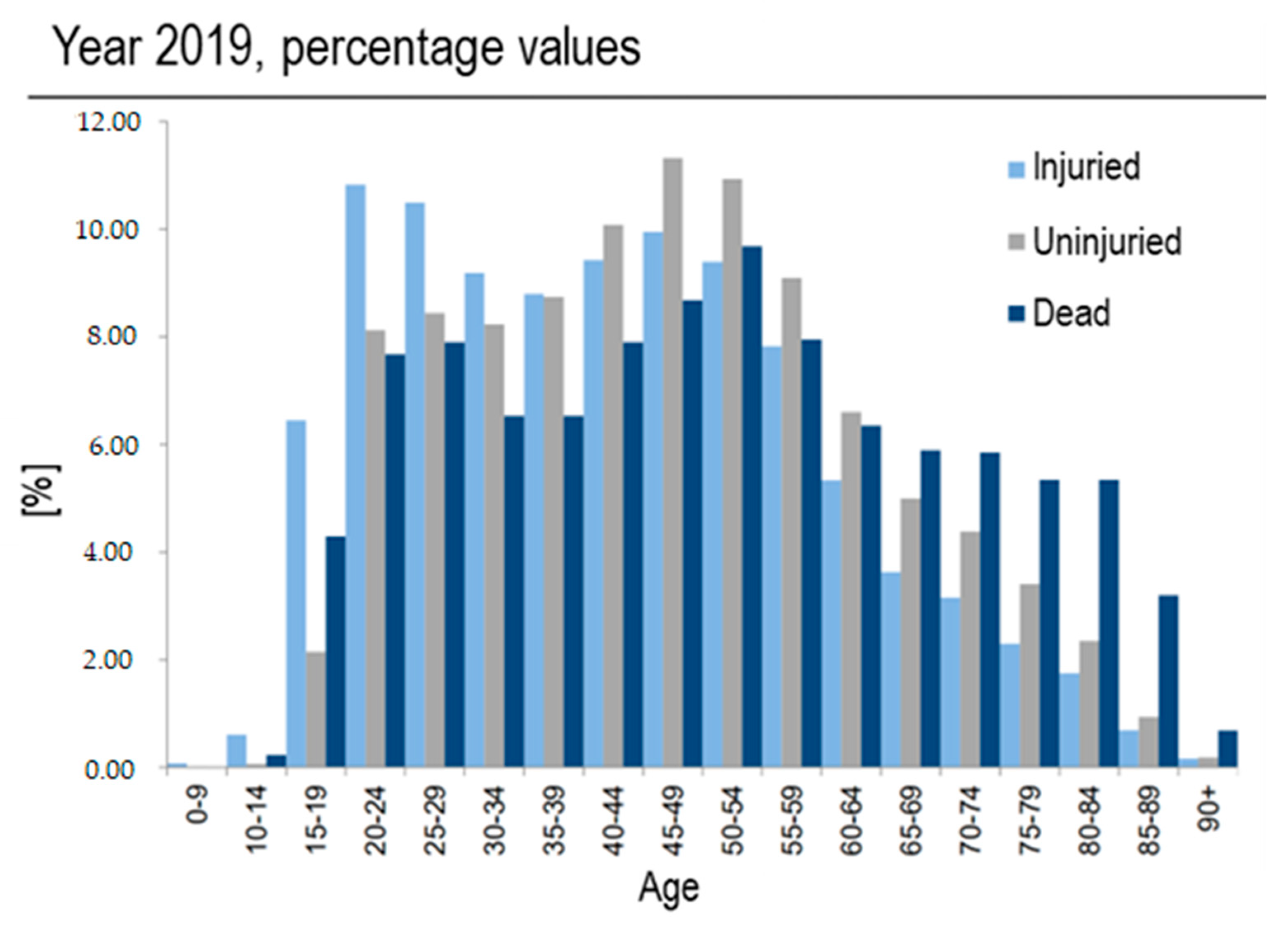


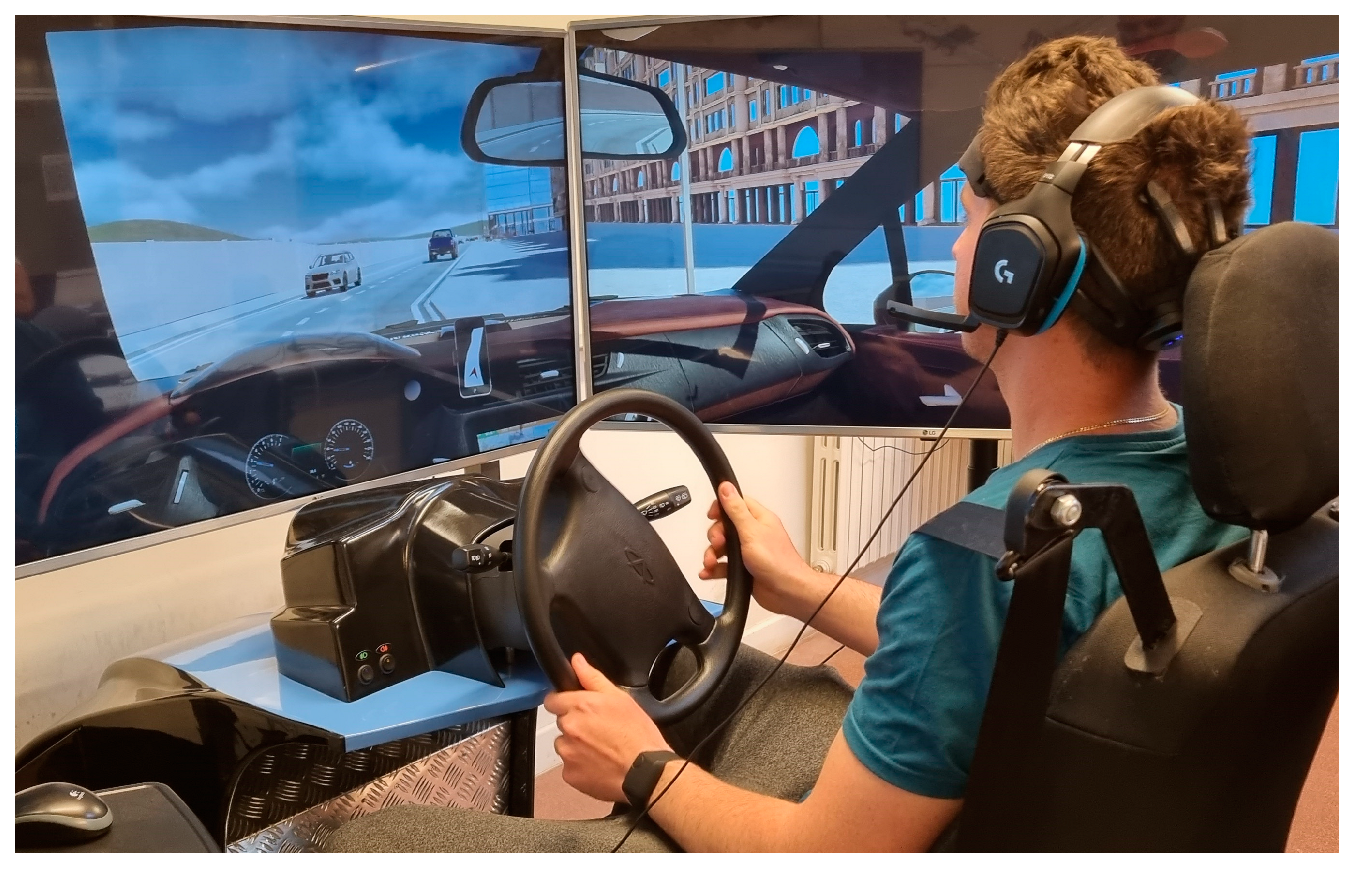
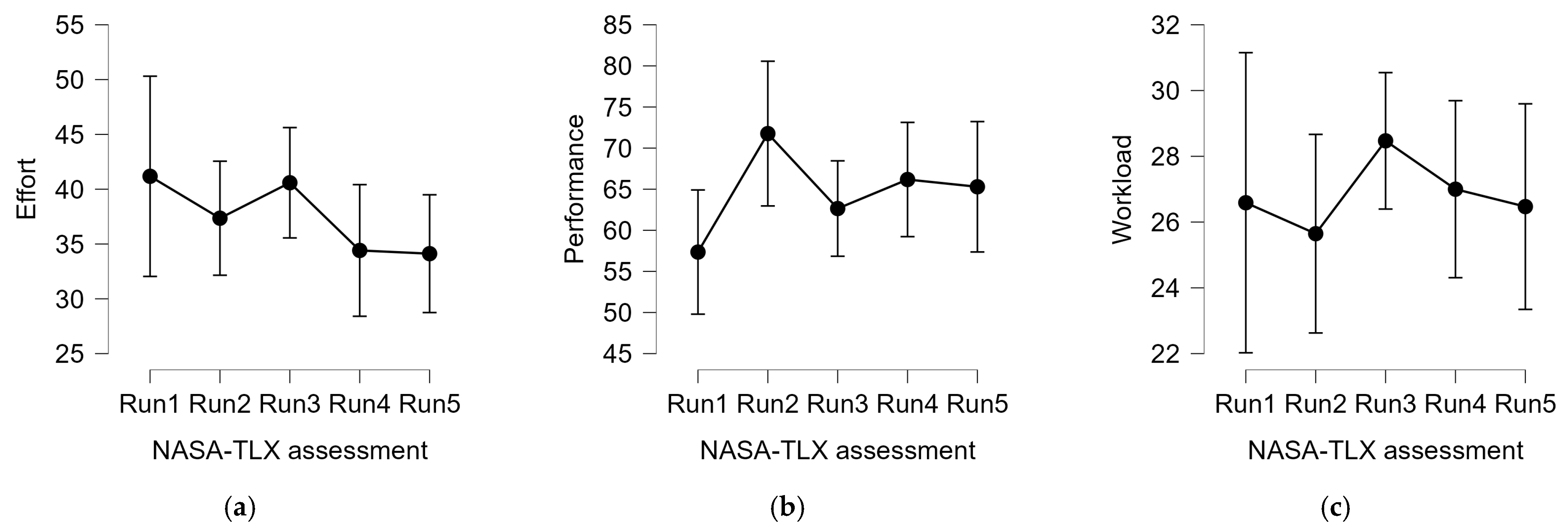
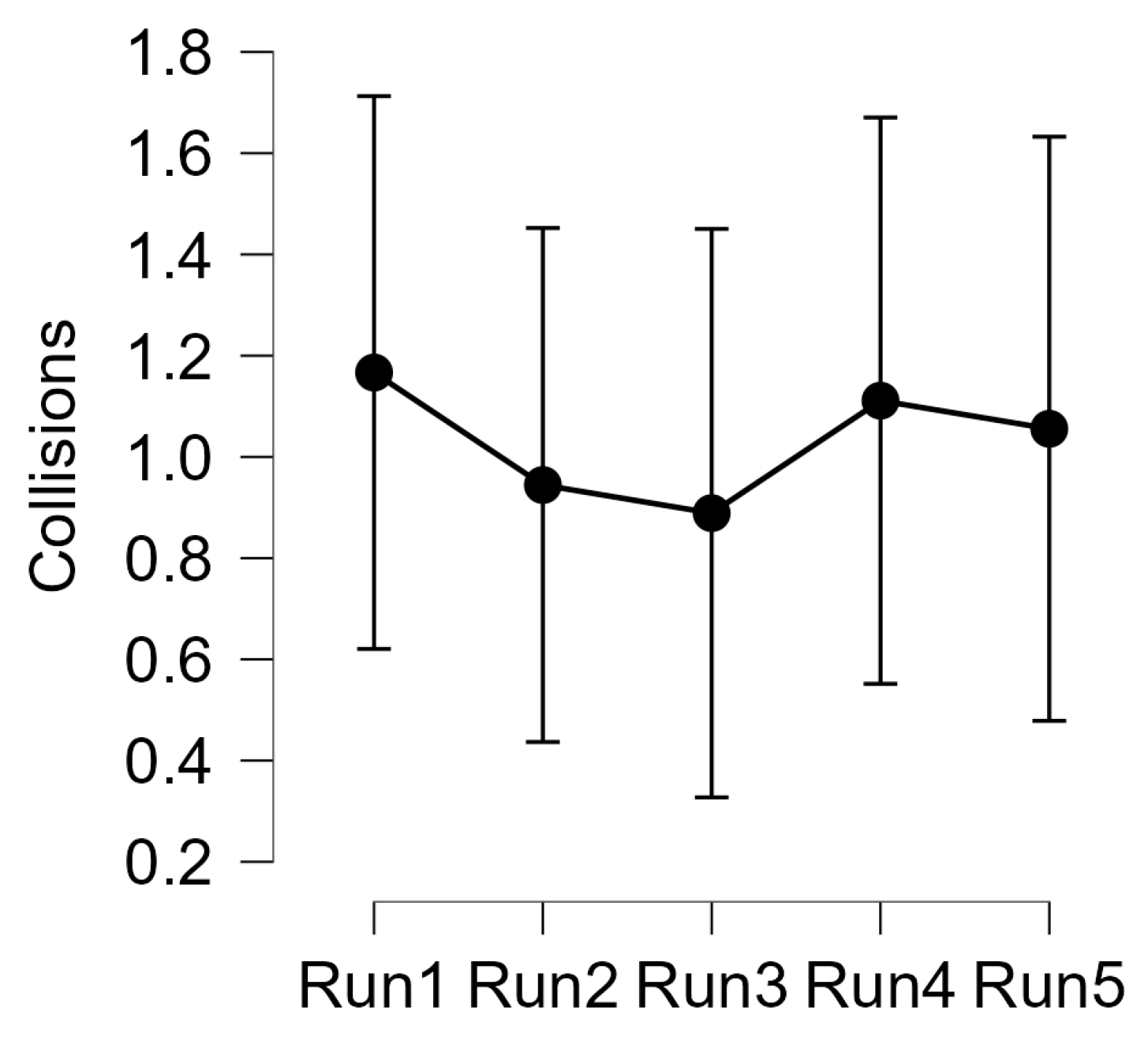
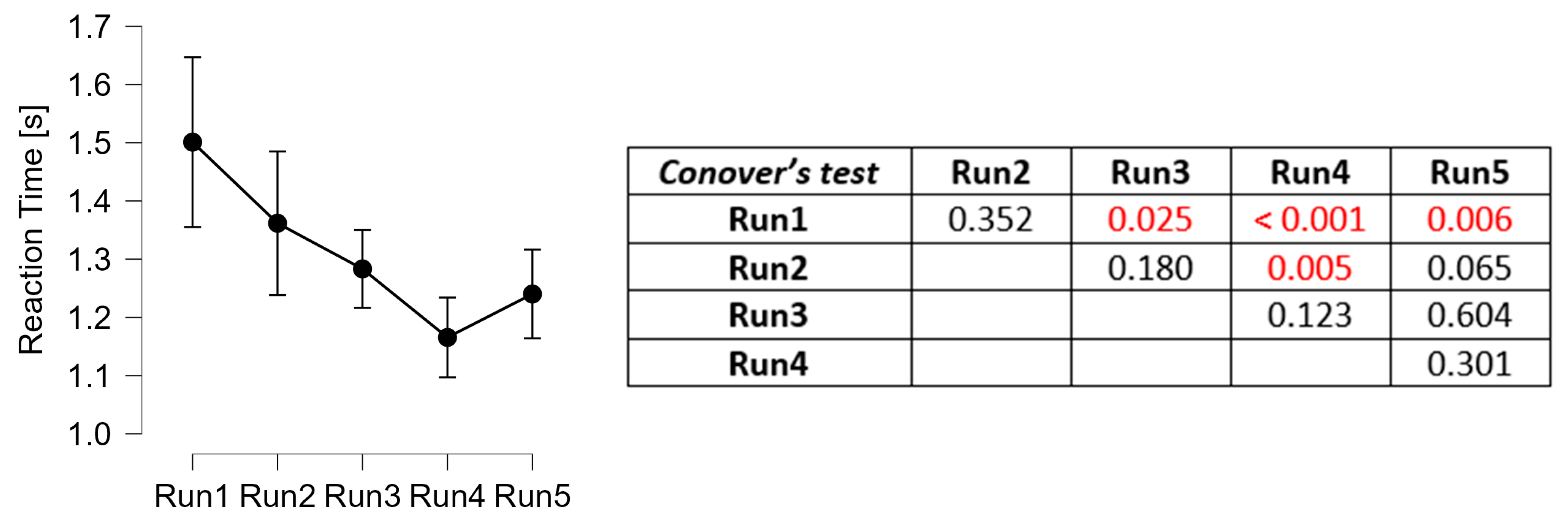

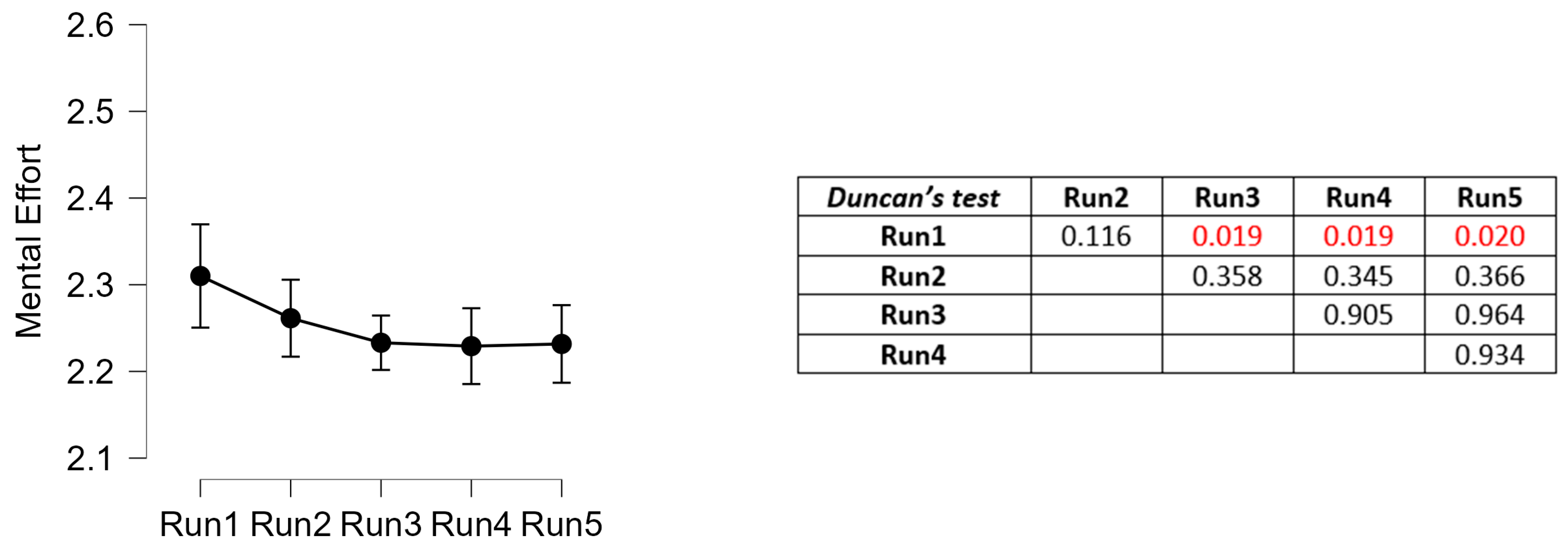
| “Driving Trainees Training” Protocol Total Duration ≈ 90 min |
| 1. Adaptation driving task 2. Open eyes condition 3. Closed eyes condition 4. Hard driving task 5. Easy driving task 6. Urban driving task*—Run1 7. NASA-TLX 8. Urban driving task*—Run2 9. NASA-TLX 10. Urban driving task*—Run3 11. NASA-TLX 12. Urban driving task*—Run4 13. NASA-TLX 14. Urban driving task*—Run5 15. NASA-TLX |
Disclaimer/Publisher’s Note: The statements, opinions and data contained in all publications are solely those of the individual author(s) and contributor(s) and not of MDPI and/or the editor(s). MDPI and/or the editor(s) disclaim responsibility for any injury to people or property resulting from any ideas, methods, instructions or products referred to in the content. |
© 2023 by the authors. Licensee MDPI, Basel, Switzerland. This article is an open access article distributed under the terms and conditions of the Creative Commons Attribution (CC BY) license (https://creativecommons.org/licenses/by/4.0/).
Share and Cite
Di Flumeri, G.; Giorgi, A.; Germano, D.; Ronca, V.; Vozzi, A.; Borghini, G.; Tamborra, L.; Simonetti, I.; Capotorto, R.; Ferrara, S.; et al. A Neuroergonomic Approach Fostered by Wearable EEG for the Multimodal Assessment of Drivers Trainees. Sensors 2023, 23, 8389. https://doi.org/10.3390/s23208389
Di Flumeri G, Giorgi A, Germano D, Ronca V, Vozzi A, Borghini G, Tamborra L, Simonetti I, Capotorto R, Ferrara S, et al. A Neuroergonomic Approach Fostered by Wearable EEG for the Multimodal Assessment of Drivers Trainees. Sensors. 2023; 23(20):8389. https://doi.org/10.3390/s23208389
Chicago/Turabian StyleDi Flumeri, Gianluca, Andrea Giorgi, Daniele Germano, Vincenzo Ronca, Alessia Vozzi, Gianluca Borghini, Luca Tamborra, Ilaria Simonetti, Rossella Capotorto, Silvia Ferrara, and et al. 2023. "A Neuroergonomic Approach Fostered by Wearable EEG for the Multimodal Assessment of Drivers Trainees" Sensors 23, no. 20: 8389. https://doi.org/10.3390/s23208389






